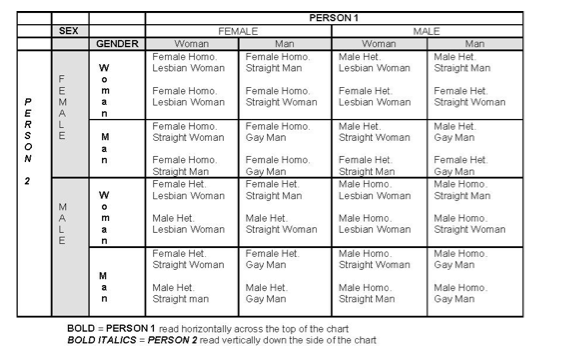Gender taxonomy
The gender taxonomy is a classification of the range of different levels at which humans vary in sexual characteristics. It is mainly used by medical specialists working in the area of sex research.[1] John Money and Milton Diamond are probably the best known researchers in this field. Money earned his PhD for research into human hermaphroditism and pseudohermaphroditism, now known as intersex conditions. The taxonomy starts at the simplest, biological level and traces differentiations expressed at the increasingly complicated levels produced over the course of the human life cycle.
- Chromosomes (46,XX; 46,XY; 47,XXY ("Klinefelter's syndrome"); 45,X0 ("Turner syndrome"); 47,XYY; 47,XXX ("Triple X syndrome"); XXXX syndrome; XXXXX syndrome, 48,XXYY syndrome, 46,XX/XY mosaic, other mosaic, and others)
- Gonads (testes, ovaries, one of each, ovotestes, other types of gonadal dysgenesis)
- Hormones (androgens: including testosterone; estrogens, including estradiol, estriol, estrone; antiandrogens and others)
- Genitals (primary sexual characteristics — see diagram for the "six class system")
- Secondary sexual characteristics (dimorphic physical characteristics, other than primary characteristics)
- Brain structure (special kinds of secondary characteristics, due to their influence on psychology and behaviour)
- Gender identity (psychological identification with either of the two main sexes)
- Gender role (social conformity with expectations for either of the two main sexes)
- Sexual orientation (gynephilia, androphilia, bisexuality, asexuality)
Types of gender taxonomy
Gendered sexuality taxonomy
Contemporary definitions and conceptualizations of sex, gender, and sexuality lack sufficient subtlety to adequately describe the full range of human sexuality (Devor, 1994).
A taxonomy of gendered sexuality, presented below, can better define the terms relevant to human sexuality and takes into account the interaction over time among sex, gender, and sexual fantasies, desires, practices of persons in intimate relationships at both the level of self-identity and attribution by others.
The taxonomy is a combination of classifications based on the genetic sexes of persons in relationships and categorizations based on those persons' social genders to arrive at classifications of gendered sexuality.
Terminology for this taxonomy was drawn from everyday language and can be used for descriptive, diagnostic, and theoretical purposes.[2]

Biological taxonomy
A taxonomy of gender also includes biological classifications of a range of sexual characteristics, which develop over one’s life cycle. The purely biological level of classifications includes chromosomes, which categorize female sex chromosome abnormalities and male sex chromosome abnormalities.[3]
- Turner Syndrome is a result from one of female sex chromosome abnormalities. Females inherit only one X chromosome (genotype is X0). Many do not survive birth and if they do they are shorter in stature and usually lack secondary female sexual characteristics. Their ovaries do not develop properly so they are sterile. If given estrogen replacement therapy around the age of puberty, women with Turner syndrome appear relatively normal.[3]
- Triple-X Syndrome is another syndrome that occurs from a female sex chromosome abnormality. Females inherit three or more X chromosomes (genotype is XXX). These “super-females” or “meta-females” appear normal except for their unusually long legs and slender torsos. They tend to be emotionally immature for their size but emotionally mature in relation to girls their same age. They sometimes have learning difficulties, usually in speech and language. Women with Triple-X syndrome are fertile but can have premature ovarian failure.[3]
- Klinefelter Syndrome is a syndrome resulting from a male sex chromosome abnormality. Males inherit one or more extra X chromosomes (genotype is XXY). They have higher-pitched voices with little facial and body hair. In childhood, they have learning difficulties and are more likely to be overweight. Boys are usually given testosterone at the age of puberty and often sterile. Men with Down syndrome sometimes also have Klinefelter syndrome.[3]
- XYY Syndrome is also a syndrome resulting from a male sex chromosome abnormality. Males inherit an extra Y chromosome (genotype is XYY). These “super-males” appear normal but are usually taller and produce higher levels of testosterone. In childhood they are more slender, have severe acne, are very uncoordinated, and have below average intelligence. Males with XYY syndrome are fertile and are not often aware that they have an abnormality.[3]
Notes and references
-
"A review of cross-gender taxonomies shows that previous observers have identified and labeled a homosexual type far more consistently than any other category of male gender dysphoric."
Ray Blanchard, "The classification and labeling of nonhomosexual gender dysphorias", Archives of Sexual Behavior 18/4 (1989): 315–334. - Devor, H (1994). "Toward a Taxonomy of Gendered Sexuality". Journal of Psychology and Human Sexuality. 6: 23–55. doi:10.1300/J056v06n01_03.
- "Human Chromosomal Abnormalities: Sex Chromosome Abnormalities". anthro.palomar.edu. Archived from the original on 2016-03-02. Retrieved 2016-02-22.